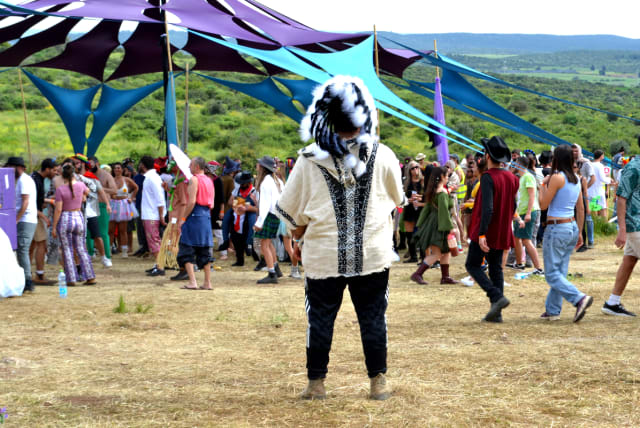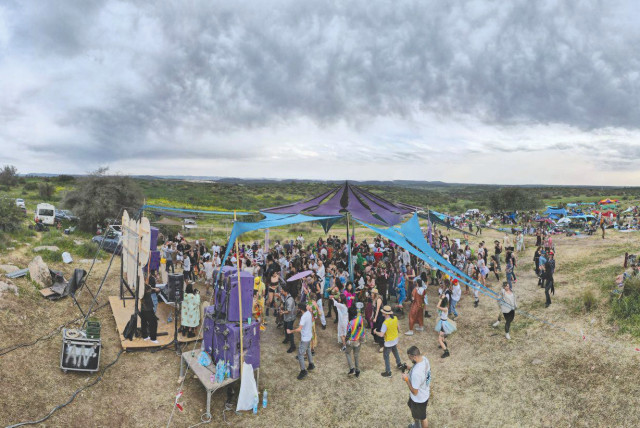Israeli trance community dances its way back from October 7 - opinion

Following October 7, after a period when people took time to digest what had occurred, trance events started up again, but in a somewhat different mode.
At 5:17 on Saturday morning, the text message comes through. “Purim is a go. Please keep these directions discrete so the event goes smoothly.”
The “event” is an outdoor trance party, taking place in a privately owned field – but if anyone stops them on the way, ticket holders are given a cover story – they’re attending the wedding of friends. The secret location is nestled within a larger backdrop of green fields, a forest and rolling hills, somewhere about 45 minutes south of Tel Aviv – and, if you count the driving slowly due to missed turns, puddles, mud and potholes in the dirt road, it is somewhere about 15-minutes off of the beaten track.
The attendees are members of one of a number of online trance, psychedelic or nature party communities. This specific online community is run by two women who are partners in the production company running the party – the only all-female trance production in Israel.
“I hope the police don’t show up,” Linoy Morad, 30, says, taking a look around the field. It’s just after 9:30 a.m. and the party has officially begun, but mostly it’s still just the crew taking a break after having gotten everything set up – dance floor, sound, stage, bar, food stand, a designated and manned “safe space” for anyone who needs it, security, ambulance, parking… People are expected to start arriving a little later.
Morad is one of the two partners. Both women are DJs, and Morad is also an artist working on her own music under the name Amigdala.
Obviously, music is at the heart of the trance community, and many people have their favorite genre – psytrance, psychedelic, Goa, dark, hi-tech… but if you ask anyone who’s been to a trance party, they’ll probably tell you that the events are more than just music. And if October 7 was the day that ensured that anyone left who hadn’t yet heard of trance now had, then for the trance community itself, it was the day that reminded them of what everything was about.
“There’s a brotherhood among the people,” says David Abramov, 47, aka DJ Darwish. His son Laor, 20, was an aspiring DJ following in his father’s footsteps, but he was murdered at the Nova party. Abramov talks about trance in the context of that day, and in general.
“I think it’s healthy for the community that when something happens – good or bad – I see them on the dance floor,” he explains. “There are people who cry, or dance in rage and let out a lot of stress from this. And there are people who dance and I feel the prayers and they are thankful to be alive. It’s a very, very emotional time.”
Why people attend trance parties
WHEN PEOPLE share why they attend trance parties – as DJs, producers or revelers – they articulate similar motivations. “We come here for the nature, for the friends, for the colorful, happy people, and because there are no politics,” asserts one young father at the Saturday event, who says he has been attending trance parties for over 15 years. He kneels as he talks and watches his wife as she dances nearby with their two-and-a-half year-old daughter, who appears to be having a great time.
Attendees say they are there to get away, to forget, to be themselves, to dance like no one is watching, to love and to be loved. Some describe trance as being close to an almost religious experience. To its adherents, trance is a community, a movement. And as with most movements, there are the loyal disciples, and there are the gurus: the ones who came before, who laid down the foundation for the current generation.
One of these is Berto Saadayev, 50, owner of Berto Simplicity Project, a family-friendly line of trance “gatherings” for an older audience. It’s an audience that also might remember a day in 1998 when Saadayev, then a fledgling party producer, went all the way to the High Court of Justice in response to the police’s refusal to issue authorization for a party, under the guise of law enforcement’s war on drugs.
“There was propaganda and this propaganda continues until this day,” he explains. “In the beginning, they called them acid parties. Acid – LSD – that was the big drug. And the police, they would get points for shutting these parties down – and the citizens, they saw this as a positive thing.”
It’s a balmy weekday afternoon and Saadayev and his associate have set out a tray of baked goods and cups of tea on a table in his backyard in Zichron Yaakov. As we sit, he weaves the story of trance and how it came to Israel.
“After the second Lebanon war, there were a lot of soldiers with post trauma and the country didn’t know what to do with them,” he says. These former soldiers traveled to the east, mostly to Goa, where they were exposed to meditation and mind-altering drugs, and were introduced to electronic club music. “They upgraded it to something more current, more psychedelic,” and brought it back home.
TODAY, some of the biggest trance artists are Israeli – Infected Mushroom, Astrix, Vini Vici, Skazi, and Eitan Reiter.
After October 7, there was an outpouring of support for the trance community, much of it grassroots from within the community itself. Reiter notes a new, more accepting approach on the part of Israeli society toward the trance scene.
“I was at a ceremony for the Nova party and the president said – there will come a time and we will dance together in nature. This was a shock from my point of view,” he says, explaining that he had never experienced acceptance from any entity that was “connected to the government… I personally sat in a lot of police stations when I only came to play music.”
He cites the 2019 protests at Rabin Square after police cancellation of the Doof Festival as an example of the reality he’d come to expect. “What I knew was – we do not want you.” But now, Reiter says, it is time for people to understand that trance is not a “marginalized” community – and that “it never was.”
Today, just as different genres of trance music exist, there are also different types of gatherings, parties and festivals. Some cater to the younger crowd, others to the older; some are family-oriented, for religious youth, or women-only; some are openly alcohol / drug-free, and others embrace the psychedelic experience through a therapeutic mind set.
Following October 7, after a period when people took time to digest what had occurred, trance events started up again, but in a somewhat different mode. Saadayev’s production, for example, held a “healing gathering” for about 50 people, some of whom were Nova survivors.
“It began with a 3-hour session of meditation, catharsis, guided imagery and reversing, and then we began down tempo and slowly went into a full ‘party,’” the trance icon says. “For some of the survivors it was the first time that they actually came out of the door of their house.”
YET EVEN with this new acceptance that some are experiencing, trance productions still operate under the threat of being shut down. Parties on private property and those under 500 attendees don’t need a license, but anything larger or on public property does – both from local authorities and the police. Some events are refused authorizations, organizers say, and even licensed events are shut down once they have begun, with official reasons usually citing unspecified noise complaints, or public safety issues.
And while event producers say they go to great lengths to meet the standards required for law enforcement’s green light, they also say they still never know when the police will show up or what they will do. “We had the police stop by twice,” Morad, the producer of the Saturday event says several days later. “The first time they saw that we had permission of the property owner and left. The second time they came, they were harder… but when they saw an older audience, security and an ambulance, they left again.”
Back to the Saturday morning trance party. It’s chilly out. Moran Caspi, 39, a mother of three, is working the food stand. You can see the October 7 Nova tattoo on her arm; she and her husband both survived. Since it’s still slow, she takes a break to sit in her car and talk. Less than a year ago, a friend took her to her first trance party. Caspi says she was surprised by the fact that men were not hitting on the women – people were “dancing with themselves” and ok with it.
“I didn’t know if they were beautiful people because they smiled all the time, or if it was because they had good energy.” But today, after all she has experienced, Caspi says she knows why. “When I see people hugging today, I understand. I don’t need to say I’m a Nova survivor. People come and give me a hug for no reason.”
Jerusalem Post Store
`; document.getElementById("linkPremium").innerHTML = cont; var divWithLink = document.getElementById("premium-link"); if (divWithLink !== null && divWithLink !== 'undefined') { divWithLink.style.border = "solid 1px #cb0f3e"; divWithLink.style.textAlign = "center"; divWithLink.style.marginBottom = "15px"; divWithLink.style.marginTop = "15px"; divWithLink.style.width = "100%"; divWithLink.style.backgroundColor = "#122952"; divWithLink.style.color = "#ffffff"; divWithLink.style.lineHeight = "1.5"; } } (function (v, i) { });

